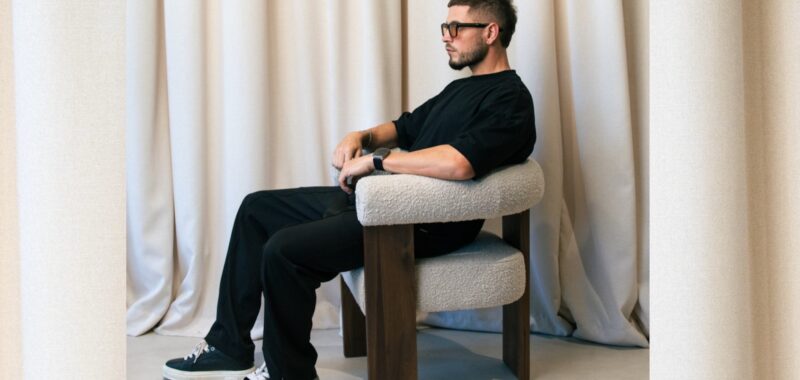In 2010, George Heaton and his brother Mike took the sewing skills their grandmother taught them and launched their own graphic T-shirt streetwear brand called REPRESENT. Fast forward to today, and the proudly British brand has wildly expanded its offerings and its reach. In 2023, REPRESENT boasted $100 million in sales, and in 2024 they opened their first store in L.A., a permanent shop-in-shop in Harrods in London, and opened their first UK flagship store in Manchester, their hometown. Not bad for a brand that started as a college project.
Entrepreneur spoke with George Heaton to learn about the brand’s origin, the strategies he and his brother have used to achieve such monumental growth, and to get his advice for aspiring style entrepreneurs looking to bring their vision to life.
The first piece
“This was originally a college project. For my design degree, I was to create something that would sell within the realm of graphic design. At that time, like 2010, there was a big American streetwear boom. We set up this website, went to a local screen printer, and printed 25 T-shirts that just said REPRESENT across the front. I sold them to my friends and my friend’s family. And then their friends came and bought some and then we printed 50 and then 100 and so on. I wanted to be this British brand that was all British-made to step away from the crowd of what printed T-shirts were. Then I wanted to take it way further and create my own jeans and jackets and wax work. So that was really like the first four or five years of what REPRESENT was.”
Related: These Sisters Started a Side Hustle After a ‘Light Bulb Moment’ Led to a ‘Versatile’ Product. Now It’s Done Over $45 Million in Sales.
Naming the brand
“I was sat in class in college and I wrote a list of 10 names on a piece of paper and REPRESENTING was one of them. And a friend of mine looked over and said, ‘Just take the -ing off that and it looks good.’ And that’s really how it came about.”
A family passion
“My brother, who’s my partner, also did graphic design. My grandma was a seamstress and taught us how to stitch, cut and sew. So I would restitch all my clothes as a teenager and I was able to understand how garments fit and flow and fabrics and how things would drape. My first hire was an actual fashion student who knew how to create and cut up a garment, and then we used me and my brother as the fit models. That’s how we made our first products that weren’t just off-the-shelf T-shirts and hoodies.”
Related: ‘Here We Go Again’: Spanx Inventor Reveals Her New Invention in Viral Post
Standing out in a crowd
“We introduced a fit of denim that wasn’t on the market and that became our bread and butter for many years. It was quite slim and had a stretch to it and it was very stacked at the bottom. I made that with my grandma from a pair of denim that were called monkey jeans. We just adjusted the fit and then sent them to a random factory that I didn’t know. I didn’t have the money to use a well-known factory that would require an order of 5,000 or something like that. And I got this sample back and I was like, ‘This is the jean that I need, that I want. So let’s see if everyone else does.’ We put it online and it just it’s it took off for us. We were selling 100 pairs a day with no marketing.”

Credit: REPRESENT
Going beyond denim and T-shirts
“I didn’t want to become just a denim brand. I wanted to be a fashion brand. I wanted to be able to attack all the categories and supply the full wardrobe for our customers — we were just making clothes for ourselves. So we went into footwear, we went into pants, went into leather jackets, went into wax work and leather goods. And I credit that for getting us where we are now. We’re known as a brand that can chop and change into different categories and not get lost in one. Right now denim is probably 4 percent of our business. Back in 2015, it was 95 percent of the business. So if we had just stuck to being the denim brand, we probably wouldn’t have been able to see that through the hard times that denim has had.”
Related: NFL Great Stefon Diggs Has a Plan to Change the Game in Fashion
The importance of brick-and-mortar
“Having a store is massively important for advocacy, especially if you’re a luxury brand and you’re trying to sell at a high price point. People want to be able to touch and feel so they can know what the fabrics are and the quality of that piece. They need to understand how much work and effort goes into this.”

Credit: REPRESENT
Advice for future fashion entrepreneurs
“It’s really important to know what you’re strong at and what you’re weak at. I’d realized over the years that my creativity was getting pushed to the side to be able to handle the business. It was terrible for the business because that was what I was good at. When I managed to hire a CEO, I was able to keep my mind in the creativity and the content and the product side of things, which I love. So I think finding the right people to cover your weaknesses and then relying on yourself for your strengths is such a critical thing, and it was for us in our business.”

